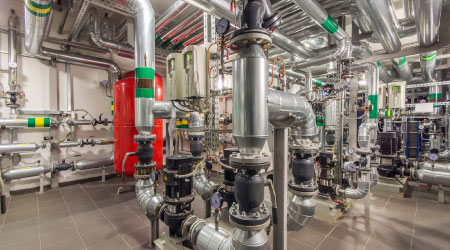Smart Pumps Lead the Way to Energy Efficiency and Sustainability Goals
The growing trend toward building electrification means it’s time to consider how smart pumps can bring energy savings.
Although the full impact of pumps in our society sometimes falls under the radar, what hasn’t gone unnoticed is energy efficiency and sustainability. When it comes to whole-building energy efficiency and sustainability, pumps are front and center and play a critical role in helping facilities reach these goals.
“As demand grows to enhance the efficiency and sustainability of municipalities, a surprising amount of energy and cost can be saved by reconsidering the designs of pump systems,” says Peter Gaydon, director of technical affairs at the Hydraulic Institute. “The pumps responsible for heating and cooling buildings, treating and distributing water, and generating power are often overlooked in conversations around smart or sustainable cities. But when pumps can account for 40 percent of industrial energy usage, it’s imperative for the decision-makers in commercial building, public and private utilities, and power generation to look beyond what’s on the surface and make adjustments to the unseen technology that powers our lives.”
Specifically, today’s smart pumps use a combination of Variable Frequency Drives (VFDs), sensors and Internet of Things capabilities to manage the flow of energy based on demand. These sensors will automatically adjust operations through the VFD or collect and share data of building or utility management systems to analyze demand performance over time. This results in great system efficiency by reducing energy usage and reducing the total cost of ownership for the pump system, Gaydon says.
Conversely, system operation of traditional pumps relies on valves opening and closing to vary the flow rates, while the pump remains at maximum speed. Smart pumps can reduce speeds to meet the system demand, resulting in 50 percent or more energy savings for the pumping systems, he added.
In New York City, air source heat pumps (ASHP) have been around for decades, but the skyrocketing cost of oil and gas, along with the impending demands of New York City’s Local Law 97 (LL97), have made the technology more intriguing for some owners and developers. LL97 regulations require that most buildings that are 25,000 square feet or larger reduce their carbon emissions by 40 percent by 2030, and by 80 percent by 2050. This, in turn, is expected to help the city itself reduce its overall emissions by similar levels.
ASHP technology remains expensive to install in new buildings, and even more so in retrofits, but the energy demands of facilities can make ASHP a desirable choice for owners. No matter what kind of heat pump, circulator pumps play an important role because they work like a heart to circulate the water throughout the building and increase the system pressure.
An example of using ASHP in an existing building is Silverstein Properties and Taconic Partners’ Hudson Research Center, a 320,000-square-foot, mixed-use life sciences lab and office complex in midtown Manhattan, where the largest such unit is being installed on the building’s roof.
The building’s owners are expecting that ASHP will produce advanced heat recovery and reduce the building’s overall energy consumption, helping it meet LL97’s fossil fuel-reduction requirements and supporting the developers’ commitments to sustainability. That’s according to Anthony Montalto, a mechanical engineer and a partner in Jaros, Baum & Bolles, a Manhattan-based engineering firm that designs ASHPs and is the mechanical, electrical and plumbing engineer for the Hudson Research Center.
Commercial office buildings in New York City have traditionally been heated by gas-fired boilers, Montalto says. However, the city is pivoting in the design of new buildings toward building electrification, he says. Instead of gas to heat buildings, electricity is now used to heat buildings through the use of air source heat pumps. Once electricity provides power to an ASHP, that pump uses the building’s refrigeration cycle to produce hot water to heat buildings.
By 2030, most new buildings could consume zero net energy. But in the energy savings game, there are no silver bullet. Neither is any moonshot needed. Efficiency oriented tech tools such as sensors, controls, pumps, and advanced energy modeling are multiplying and ready for wide adoption.
Pump enhancements
Traditional pumps have been responsible for comfort, efficiency, and sustainability. But pump enhancements are now keys to feeding a thriving market of smaller pumps for commercial buildings.
“In the Northwest, high-rise buildings are our primary market, followed by campus-style universities, hospitals, and office facilities,” says Devin Carle, president of Hurley Engineering.
He notes that more facility managers and building owners began to pay more attention to pumps when the U.S. Department of Energy started talking about energy efficiency regulations. “It was like someone had thrown a switch,” he says.
In the Pacific Northwest, the regional utilities, as part of the Northwestern Energy Efficiency Alliance, started to provide information and incentives for the purchase of efficient pumps. “While pumps themselves are not a major cost in buildings, they can have a big impact on chiller system operations and user comfort,” he says. “That’s something building owners care about.”
For building owners to assess and implement new pump systems, including smart pumps for more sophisticated and efficient energy management, “It’s critical to evaluate what the system is currently controlling and the needs of that system in order to ‘right size’ the pump system for the demand,” the Hydraulic Institute’s Gaydon says. Asking simple questions, like when is energy consumption at its highest during the day, can put building owners on a path to significant energy and cost savings, he added.
As many commercial and municipal building owners are not well-versed in the engineering needs of the system, it’s also important for building engineers and architects, as well as pump manufacturers, to share information about new options with owners.
California’s building sector contributes around a quarter of the state’s greenhouse gas emissions, and regulators see heat pump water heating systems as promising tools to reduce that. Heat pump systems tap into the electric grid to heat water, and as the state’s electricity mix grows cleaner, they can offer a cleaner and more efficient alternative to natural gas water heating.
We’ve reached a tipping point when it comes to pumps. Many facility managers are recognizing that pumps can well be the next big thing in building sustainability, energy efficiency, and lowering utility costs.
Michael B. Michaud is the Executive Director of the Hydraulic Institute, the largest association of pump industry manufacturers in North America.
Related Topics:












